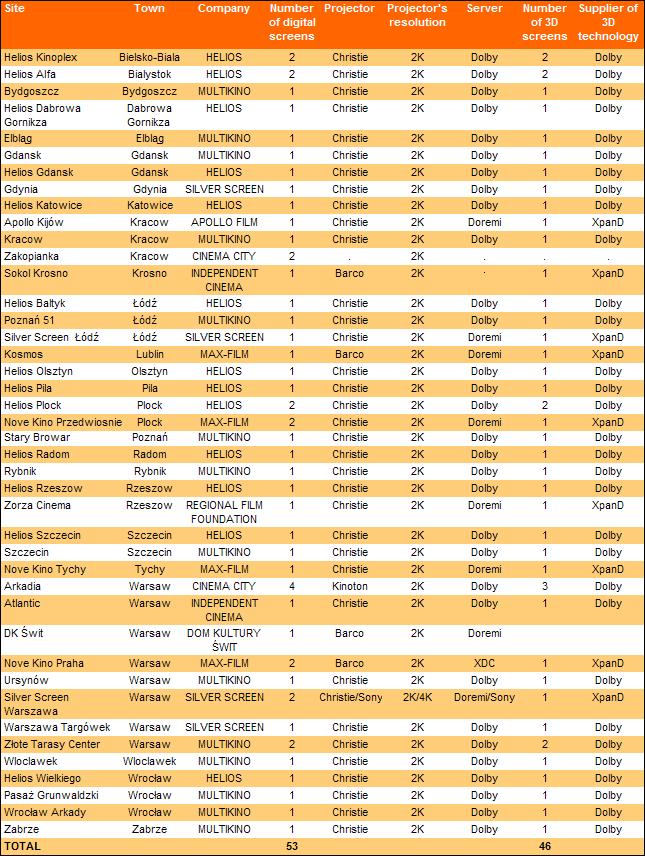
Reg.
Trib. Milano n. 418 del 02.07.2007
Direttore responsabile: Elisabetta Brunella![]()
![]()
International Edition No. 48 - year 4
28 July 2009
***
 Dear
readers,
Dear
readers,
the latest figures on digital cinema installations in Europe can be
characterized by the phrase: “slowly but surely”. Even though
the majority of markets are hesitant, the perspective is clear. Driven
by 3D and a wish to be forerunners, even some small operators have been
urged to do it their own way without waiting for an overall national
(business) plan. From a political point of view this is maybe not too
smart as it might leave the impression that (even) small cinemas can
manage this huge investment on their own. On the other hand it is understandable
that some operators lose patience while organizations battle it out
with distributors, potential public funds and film institutions. The
view is that especially small cinemas have a need to “stand out”,
to make offers that the general audience cannot refuse.
In this context MEDIA Salles feels a powerful need to provide a service
to cinemas by giving information and hands-on courses in the digital
field. After two consecutive and highly appreciated editions in London,
we plan to organize the next training course on digital cinema in Helsinki
in February 2010. There is a strong political wish in Finland to push
the new technology forward and a pot of money has been put up by the
Film Institute as feed money. The “DigiTraining Plus 2010”
course will again highlight the financial issues and hopefully bring
new solutions to the table – crisis or no crisis.
Jens Rykaer
President of MEDIA Salles
(Per leggere il testo in
italiano cliccare qui)
WOMEN IN DIGITAL CINEMA
Ksenya Leontyeva, Senior Analyst, Nevafilm
Research
 I
took up the post of analyst at the Nevafilm Company in the middle of
2006; and that year saw the beginning of the digital era in Russian
cinema exhibition.
I
took up the post of analyst at the Nevafilm Company in the middle of
2006; and that year saw the beginning of the digital era in Russian
cinema exhibition.
The first permanent commercial digital screen was opened on 26 October
2006 in Saint Petersburg: it was situated in Zanevsky Kaskad cinema
and equipped by the Nevafilm Cinemas department. For several years previously
our company had been making great efforts to prepare this event: from
explanations about what DC is (we opened a website www.digitalcinema.ru)
up to the equipping of the first temporary digital screens (even with
1.3K resolution) as far back as 2003–2004 in Moscow. So, I was
very proud to join Nevafilm during such an important moment.
As I am a researcher, first of all I am in charge of monitoring the
Russian cinema exhibition market: we count the number of 35mm and digital
screens in the country. I also keep in touch with the exhibitors and
record their successes and difficulties. In addition, our research department
supplies advice and draws up analytic reports about the current situation
in the Russian exhibition market in the pages of our quarterly magazine
Cinemascope, which I publish as chief editor, and at our site (www.nevafilm.ru).
I am very glad to be a part of the Nevafilm Company, which promotes
the deployment of digital cinema in Russia (not only with the help of
the research and equipment departments, but also by means of the digital
cinema laboratory and distribution of alternative content). Sometimes
I regret that the time of 35mm copies is coming to an end: it was a
very romantic epoch. However the new digital age must be no less interesting
than the age of 35mm and will bring boundless opportunities for the
creative work of cinematographers.
(Per leggere
il testo in italiano cliccare qui)
"Open Doors" meeting – an occasion to know more about the "DigiTraining Plus" course
The “Open Doors” meeting took
place in Warsaw on 22 April 2009. This gathering was organized by the
MEDIA Desk Poland to present the EU MEDIA Programme’s training
initiatives all over Europe, covering every aspect of the cinema chain.
In the session devoted to digital cinema, the “DigiTraining Plus”
course was introduced, with a presentation which focused on how the
course deals with the specific aspects of this new technology, in the
context of film projection.
 Alicja
Grawon, a participant at the 2009 edition of the course, shared her
experience with those who attended the meeting, giving an overview of
the course and answering some questions on the approach used during
the course to explain what digital cinema is, what kind of added value
it brings to the cinema industry, the importance of alternative content,
the European market prospects for the digital distribution of a movie,
statistics on digital cinema in Poland and other European countries.
She also answered practical questions about the accommodation, the course
fees etc.
Alicja
Grawon, a participant at the 2009 edition of the course, shared her
experience with those who attended the meeting, giving an overview of
the course and answering some questions on the approach used during
the course to explain what digital cinema is, what kind of added value
it brings to the cinema industry, the importance of alternative content,
the European market prospects for the digital distribution of a movie,
statistics on digital cinema in Poland and other European countries.
She also answered practical questions about the accommodation, the course
fees etc.
Many young film makers visited the ”Open Doors” meeting,
learning from lectures and workshops about screen writing and film development.
According to Alicja Grawon, the session on digital cinema and the "DigiTraining
Plus" course was particularly successful: "it was an exceptional
presentation due to the rising interest among the participants, which
was fuelled by their lack of knowledge about digital cinema". Approximately
40 participants took part in discussions evaluating the new technology
issues, ranging from basic questions to high level problems where technical
issues and business models were dealt with.
After the conclusion of the conference, issues relating to each particular
training course were discussed with the participants on a one-to-one
basis.
Alicja Grawon is a digital cinema specialist at the National Chamber of Audiovisual Producers and the author of a BA thesis entitled “Digital Cinema and the Future of Cinematography” at the Department of Radio and Television of the Silesian University in Warsaw. In 2007 she was director's assistant on the set of It’s a free world directed by Ken Loach, and in 2008 she was director' assistant on the set of An ideal guy for my girlfriend directed by Tomasz Konecki. She has also done an internship at Chimney Pot - a post-production company in Warsaw - where she put into practice her knowledge of new production technologies, as well as discovering the technical aspects of digital cinema.
(Per leggere il testo in italiano cliccare qui)
To see the digital sites and screens situation in Poland as at 1st January 2009, as published in the “European Cinema Yearbook – 2008 edition” click here
| Save the
date:
17 – 21 February 2010 The seventh edition of the “DigiTraining Plus: European
Cinemas will take place |
| at the 62nd Cannes Film Festival the “European Cinema Journal no. 1/2009”. In this issue: the tables
on digital sites and screens situation in Europe as at 1st
January 2009, an interview with Michael Karagosian, Senior
Digital Consultant at NATO (US) and a report of the 2009 edition
of the “DigiTraining Plus” course. |
Digital screens grow all over Europe
In 12 months Europe’s digital screens have
grown by 71%: these are the latest figures published by MEDIA Salles,
whophotographed the situation at 1st January 2009. The analysis, presented
at the 62nd Cannes Film Festival, during the seminar conducted by
the European Audiovisual Observatory, for which MEDIA Salles last
year became official provider of statistics on the new technologies,
shows that the number of DLP Cinema or Sony 4K projectors has risen
from 897 to 1,535. The number of cinemas fitted with at least one
digital screen has grown to 821 with a 49% rise compared to twelve
months previously. The fact that every site has an average of 1.9
digital screens compared to the previous 1.6 is confirmation that
exhibitors are increasingly converting more than one screen per cinema
to the new technology, both in order to offer digital screenings during
the whole of a film’s commercial run and to offer greater flexibility
in the face of changing demands.
2008 has experienced a rise not only in digital installations but
also in the countries where the new projection technology has been
introduced: with the new entries – Estonia, Croatia, Latvia,
Malta and Romania – the number has increased to 30. If we can
affirm that a little under 5% of all Europe’s cinemas have converted
to digital, it must be remembered that in this field, too, each market
proceeds at its own pace.
In absolute terms, the United Kingdom once again comes “top
of the list” with 303 screens distributed mostly within the
Digital Screen Network, the first public initiative in Europe, approved
in 2005, to support the digital transition in cinemas. Due to the
lack of further public financing, however, the growth in screen numbers
has slowed down, to the extent that in 2008 there were only 19 new
installations. France, on the contrary, is rapidly catching up with
the United Kingdom, having increased the number of its digital screens
almost fourfold and growing to 253 compared to 66 the previous year.
This growth is mainly due to CGR, the third largest exhibition company
in France, which has commenced conversion of its approximately 400
screens on the basis of a VPF agreement signed with Arts Alliance
Media. France has even outstripped Germany which, after having conceived
the project known as “model 100” to finance digital transition,
is now taking time out for reflection. This is demonstrated by the
fact that in 2008 the number of digital theatres increased by 10 only,
to reach 162. A more dynamic picture emerges in a series of territories
with diverse characteristics: both markets that already had a significant
digital base with respect to the total number of screens, i.e. above
the European average, and countries that up to the beginning of 2008
proved to be little interested in the new technologies in terms of
their overall screen numbers. The first group includes Austria, growing
from 35 to 84 units, Luxembourg (from 13 to 21), the Netherlands (from
34 to 56), Norway (from 35 to 48) and Iceland (from 3 to 7). The second
group embraces Switzerland (from 16 to 28) and, even more so, Italy,
which during 2008 more than doubled its digital screens (from 38 to
80 units), as well as countries that triple their figures, such as
Portugal (from 14 to 44) and the Russian Federation (from 31 to 90),
or increase them fourfold, such as Bulgaria (from 4 to 17), or even
six times, like Poland (from 8 to 53). Amongst the “new entries”
Romania stands out, with a leap from zero to 14 digital projectors.
All this activity shows that there are now 7 countries that boast
a digital screen density of over 10% with two, Belgium (18.8%) and
above all Luxembourg (75%), that leave the European average far behind
them, thanks mainly to the initiative of Utopolis and Kinepolis, companies
that opted for digital some time ago. As regards the economic model
used to finance the transition, Europe continues to follow a line
that relies mainly on the exhibition companies’ own resources,
integrated at times by public financing. What motivates private investment
in the new technologies is mainly the potential development in demand
that the cinema industry sees in 3D. This is confirmed by the figures
on the first few months of 2009, when the launch of world premières
such as Bolt, Journey to the Centre of the Earth and Monsters vs Aliens
saw a new wave of digital screen installations, which it is believed
will be partly amortized by the higher price that audiences are willing
to pay for this novel product. The economic model known as VPF, whose
widespread adoption was one of the engines of growth in the first
phase of large-scale digitalization in the United States, has started
to have followers in Europe, too: as well as the above-mentioned CGR,
Cineplexx Kinobetriebe in Austria and ZON Lusomundo in Portugal also
announced in 2008 that they had signed contracts foreseeing the figure
of the so-called “integrator”. Briefly, “adelante,
con juicio”: Europe is proceeding in its digital transition,
but is not in a rush.
Elisabetta Brunella
The statistics on digital cinema sites and screens
in Europe as at 1st January 2009 are available on MEDIA Salles’
website, in the “Digital Cinema: Focus on Europe” section
of the “European Cinema Yearbook – 2008 final edition”.
Click
here to see it
(Per leggere il
testo in italiano cliccare qui)
Digital Cinema and SMPTE at the 2009 Mostra del Cinema di Venezia
 Digital
cinema is more and more present at the Mostra Internazionale d’Arte
Cinematografica in Venice. For the 2009 edition (2 – 12 September),
in fact, the digital screens will increase from five to seven units.
Out of these seven screens, two, that of the Sala Grande and of the
Sala Perla, will also be equipped with 3D technology, provided by Xpand.
The Venice Film Festival will thus be the first in the world to be able
to present 3D stereoscopic screenings in two screens.
Digital
cinema is more and more present at the Mostra Internazionale d’Arte
Cinematografica in Venice. For the 2009 edition (2 – 12 September),
in fact, the digital screens will increase from five to seven units.
Out of these seven screens, two, that of the Sala Grande and of the
Sala Perla, will also be equipped with 3D technology, provided by Xpand.
The Venice Film Festival will thus be the first in the world to be able
to present 3D stereoscopic screenings in two screens.
For the first time the Mostra will present an award for achievements
in digital cinema.
The annual meeting of SMPTE at the Lido, organised by Angelo D’Alessio
on digital cinema, is scheduled for 8 September 2009. For more information,
please visit the official website www.smpte.org
(Per leggere il testo in italiano cliccare qui)
News on the development of digitalisation in the world New digital installations for Digima Italia With the ambitious goal to
reach 200 digital installations in 3 years, Digima has recently
signed some important agreements in Liguria, Emilia Romagna and
Piemonte (Italy). The cinemas Politeama Dianese, in Diano Marina
(IM), Ariston, in Sestri Levante (GE) and Centrale, in Santa Margherita
Ligure (GE) are the first 3 cinemas in Liguria which have chosen
DIGIMA for the digitalisation of their screens. They will be equipped
with digital projectors Christie CP2000ZX, server DCP 2K Doremi
and 3D system Xpand and RealD. The digital shift will take place
at the end of July and the first big appointment will be the release,
also in 3D, of the movie The Ice Age 3. |
More2Screen to show
operas in India and Russia More2Screen, a London-based alternative content provider, has just signed a deal with Indian exhibitor Big Cinemas to screen operas and classical concerts in Indian cinemas. Thanks to the partnership between More2Screen and UK’s Glyndebourne Festival (see DGT online informer no. 37), a varied selection of operas – starting from La Cenerentola, Giulio Cesare and a tribute concert to late tenor Luciano Pavarotti, which was held in Petra, Jordan – started screening at the end of June 2009, thus answering to a big request from Indian public for international cultural experiences. A similar contract has been signed between More2Screen and Saint Petersburg-based company NevaFilm, for the screening, in selected cinemas across Russia, of the tribute to Pavarotti. (Per leggere il testo in italiano cliccare qui) |
XDC to deploy 170 digital
screens in Eastern Europe with Palace Cinemas During Cinema Expo 2009 in Amsterdam, Palace Cinemas and XDC announced an agreement including the roll out of digital projection systems co-financed by the Virtual Print Fee (VPF) model, which is scheduled to begin in the second half of 2009 in 20 cinemas across Czech Republic, Slovakia and Hungary. This is XDC’s third major VPF deal in Europe. They will exclusively install DCI-compliant digital projection systems and XDC’s CineStore® Solo G3 D-Cinema servers. (Per leggere il testo in italiano cliccare qui) |
The success of “Ice Age 3” in
Russia and Greece |
Digital sites and screens
situation in Poland as at 1st January 2009
Taken from MEDIA Salles' "European Cinema Yearbook
- 2008 final edition"

© copyright MEDIA Salles
MEDIA Salles’ contacts and address
MEDIA Salles
Piazza Luigi di Savoia, 24 – 20124 Milano - Italy
Tel.: +39.02.6739781 – Fax: +39.02.6690410
E-mail: infocinema@mediasalles.it
Sito web: www.mediasalles.it